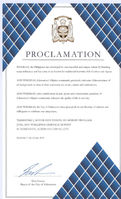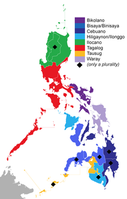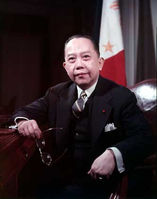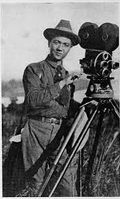
PHILIPPINE HERITAGE MONTH 2020
30 Days of Philippine Heritage
June 2020
With government restrictions on physical distancing still in place, Philippine Arts Council celebrates Canada Philippine Heritage Month this year with 30 DAYS OF PHILIPPINE HERITAGE - snippets of information on Filipino-Canadians and Philippine culture and traditions, each day, for 30 days, in the month of June.
Watch out for posts here and in the Philippine Arts Council's social media accounts in Facebook, Instagram and Twitter.
#PHM #PhilippineHeritageMonth #Filipino #Heritage #30days
Message from
The Right Honourable Justin Trudeau
Prime Minister of Canada

Message from
Consul General Zaldy B. Patron,
Philippine Consulate General, Calgary
Message from
The Honourable Jason Kenney
Premier of Alberta
DAY 1
Canadian Proclamation of Philippine Heritage Month
On October 30, 2018, the House of Commons of Canada adopted Motion 155 declaring June as Filipino Heritage Month in Canada from coast to coast, in a unanimous vote. Federal Liberal Salma Zahid, who is Member of Parliament for Scarborough Centre in Ontario, sponsored the motion beginning in February 2018.
In her privilege speech, MP Zahid said, "This motion recognizes, celebrates and raises awareness of the Filipino community in Canada. It is also a way of showing our Government's official appreciation of the Filipino community for their important contribution throughout Canadian history and for helping to make our country the rich and vibrant place it is today."
DAY 2
Proclamation of Philippine Heritage Month in Alberta
On Friday June 1, 2018, the office of Deputy Premier Sarah Hoffman announced that Premier Rachel Notley and Lieutenant Governor Lois Mitchell have signed the proclamation making the month of June as Philippine Heritage Month in perpetuity. This month coincides with the annual celebrations of Philippine Independence Day across Canada. This made Alberta the first and only province to proclaim Philippine Heritage Month.
“Alberta is the proud home to the second-largest Filipino population in the country. For decades, Filipinos have enriched our province with their culture, their languages and their skills.” - Premier Rachel Notley
On June 25, 2018, the NDP Caucus hosted a Celebration of Philippine Heritage Month at the Federal Building, with the Filipino community.
DAY 3
Municipal Declarations of Philippine Heritage Month in Canada
In 2018, municipal declarations of June as Philippine Heritage Month were made in the Cities of Edmonton, Calgary and Fort Saskatchewan, along with the Alberta provincial proclamation.
In November 2017, the Toronto City Council also voted unanimously to designate June as Filipino Heritage Month.
DAY 4
Filipinos in Canada
Filipinos in Canada numbered around 901,218 in April 2018, comprising a mix of naturalized Canadians, permanent residents and temporary foreign workers (TFWs). This number comprises almost 2.6% of Canada’s national population.
The Philippines continues to be the top source of immigrants (15.58% of the total new immigrants) to the country.
Filipino and Filipino-Canadian population in the country are concentrated in 4 Canadian provinces – Ontario, Alberta, British Columbia, and Manitoba – as more than 90% of them reside and work in those provinces. It should be noted, however, that the top destination for Filipino immigrants during the period 2011 to 2016 was Alberta.
DAY 5
Languages
The Philippines is an ethnically diverse country with over 150 languages. Aside from Filipino/Tagalog, major languages include Aklanon, Basian, Bikol, Cebuano, Chavacano, Hiligaynon, Ibanag, Ilocano, Ilonggo, Ivatan, Maranao, Tagalog, Kapampangan, Kinaray-a, Waray, Maguindanao, Pangasinan, Sambal, Surigaonon, Tausug, and Yakan.
DAY 6
UNESCO World Heritage Sites in the Phils: Baroque Churches
Four churches in the Philippines are in the list of UNESCO World Heritage Sites - the San Agustin Church, Paoay Church, Miagao Church, and Sta. Maria Church - four Roman Catholic churches constructed between the 16th and the18th centuries in the Spanish period of the Philippines.
The churches are outstanding examples of the Philippine interpretation of the Baroque style, and represent the fusion of European church design and construction with local materials and decorative motifs to form a new church-building tradition.
DAY 7
Adobo
Adobo, considered the national dish of Filipinos, is a dark stew of chicken and/or pork cooked in soy sauce, vinegar, crushed garlic, bay leaf, and black peppercorns. In Spanish, adobo originally meant “sauce” or “seasoning.” The Filipino version is actually indigenous to the islands, dating back to a dish cooked up long before Magellan’s arrival.
DAY 8
Philippine Flag
The Philippine national flag consists of horizontal stripes of blue and red with a white hoist triangle incorporating a golden sun and three stars. The three golden stars stand for the three main areas in the Philippines—Luzon, Visayas (originally Panay) and Mindanao. The eight sun rays were for the provinces where the original anti-Spanish revolt had broken out. The horizontal stripes represent: blue - for the willingness to sacrifice oneself for freedom, over red - for courage. When the flag is flipped with the red side up, it indicates a state of war.
DAY 9
Philippine Jeepney
The jeepney is sometimes referred to as the “King of the Philippine roads.” It is a descendant of the Jeeps American troops drove in the Philippines during World War II. In the early 1950s, jeepneys began making their rounds in Manila. Soon, they became a solution to the post-war public transportation problem.
Jeepneys are famously characterized by their vibrant, multicolored paint jobs and flashy decor, so much so that through the years, they have become a symbol of the country and its culture.
DAY 10
UNESCO World Heritage Site in the Philippines: Historic City of Vigan
Vigan in Ilocus Sur is a UNESCO World Heritage Site, as the most intact example in Asia of a planned Spanish colonial town, established in the 16th century. Its architecture reflects the coming together of cultural elements from elsewhere in the Philippines and from China with those of Europe and Mexico to create a unique culture and townscape without parallels anywhere in East and South-East Asia.
Vigan is unique for having preserved much of its Hispanic colonial character, particularly its grid street pattern and historic urban layout. Its significance also lies on how the different architectural influences are blended to create a homogenous townscape.
DAY 11
Filipino Martial Arts
Kali, escrima, arnis, are ancient and traditional indigenous combat system rooted in the Philippines. It consists of different techniques: empty hands, stick & blade fighting.
It can be seen in the choreography of action scenes on film and tv like the Bourne series, Captain America: the Winter Soldier, Taken 2, Quantum of Solace, 300, Rambo 3.
.
DAY 12
Philippine National Anthem
Lupang Hinirang is actually the 2nd national anthem of the Philippines. The 1st one was commissioned by Andres Bonifacio, with the title “Marangal na Dalit ng Katagalugan” and was composed by Julio Nakpil, in 1897. Curious how the 1st anthem sounded like? Listen here - https://www.youtube.com/watch?v=KnwdzC_qfTM
In 1898, in preparation for the Proclamation of Independence, Gen. Emilio Aguinaldo asked musician Julian Felipe to compose a march befitting the occasion. The anthem remained without words until Jose Palma, a young poet-soldier thought of writing a poem entitled Filipinas to accompany the national anthem in 1899.
DAY 13
Carlos P. Romulo
Carlos Peňa Rómulo (Jan. 14, 1899 - Dec. 15, 1985) was a Filipino diplomat, educator, soldier, journalist and author - a career spanning 50 years of public service. He was the first Asian/Filipino to win the American Pulitzer Prize for Correspondence in 1942, received the Purple Heart and Silver Star from the US Army and was also the first Asian to become President of the United Nations General Assembly (1949).
In 1982, Carlos P. Romulo was proclaimed National Artist for Literature, writing and publishing 18 books. He was also conferred the first Bayani ng Republika Award for his outstanding service to the Filipino nation and the rank of Rajah of the Order of Sikatuna, an honour usually reserved for heads of state.
“I had to be outstanding,” he wrote, “to make the greatest effort to win, to prove I was capable not in spite of having been born a Filipino but because I was a Filipino.”
DAY 14
UNESCO World Heritage Sites in the Phils: Rice Terraces of the Phil Cordilleras
The Rice Terraces of the Philippine Cordilleras is a UNESCO World Heritage Site. It is an outstanding example of an evolved, living cultural landscape that can be traced as far back as two millennia ago in the pre-colonial Philippines.
Reaching a higher altitude and being built on steeper slopes than many other terraces, the Ifugao complex of stone or mud walls and the careful carving of the natural contours of hills and mountains to make terraced pond fields, coupled with the development of intricate irrigation systems, harvesting water from the forests of the mountain tops, and an elaborate farming system, reflect a mastery of engineering that is appreciated to the present.
The terraces illustrate a persistence of cultural traditions and remarkable continuity and endurance, since archaeological evidence reveals that this technique has been in use in the region for 2000 years virtually unchanged. They offer many lessons for application in similar environments elsewhere.
The maintenance of the living rice terraces reflects a primarily cooperative approach of the whole community which is based on detailed knowledge of the rich diversity of biological resources existing in the Ifugao agro-ecosystem, a finely tuned annual system respecting lunar cycles, zoning and planning, extensive soil conservation, mastery of a most complex pest control regime based on the processing of a variety of herbs, accompanied by religious rituals.
DAY 15
Pearls from Palawan
The world’s largest pearls are found in the Palawan seas.
In 1934, a Filipino diver discovered what is now known as the “Pearl of Lao Tzu,” or “Pearl of Allah,” weighing 6.4 kg and has a value of over US$40 million. It is believed to be 600 years old.
But now, another Filipino in Mississauga has unveiled a family heirloom, a 27.65 kg “Giga Pearl” appraised between $60-80 million, believed to be more than 1,000 years old. The family, who has had the pearl since 1959, didn’t even know it was a pearl and was worth anything.
DAY 16
Philippine Eagle
The Philippine, or monkey-eating, eagle, is one of the largest and most powerful of all eagles. Found only in the Philippines, it was declared the national bird in 1995. It stands up to 3.3 feet (1 m) in height and has a wingspan of almost 7 feet (2 m). It is one of the rarest birds in the world; there may only be around 180–500 eagles remaining.
DAY 17
Erythromycin Antibiotic
The antibiotic erythromycin was invented by Filipino Dr. Abelardo Aguilar in 1949. He sent a sample to his employer, the Eli Lily pharmaceutical company. In 1952, the product was launched commercially under the brand name Ilosone (after Iloilo). Later, Lily filed for patent protection, without giving any royalty to Dr. Aguilar.
Erythromycin is used to treat certain infections caused by bacteria in the respiratory tract, especially for people who are allergic to penicillin. It has saved millions of lives.
DAY 18
UNESCO World Heritage Sites in the Phils: Mount Hamiguitan Range Wildlife Sanctuary
The Mount Hamiguitan Range Wildlife Sanctuary in Davao is a UNESCO World Heritage Site. It provides a sanctuary to a host of globally threatened and endemic flora and fauna species, eight of which are found nowhere else except Mount Hamiguitan. These include critically endangered trees, plants and the iconic Philippine Eagle and Philippine Cockatoo.
DAY 19
Jose Rizal
Jose Rizal, patriot of the Philippine nationalist movement, was born on June 19, 1861. A man of extreme intelligence, he was a polyglot, would switch languages in his writings & fluent in 22 languages - Hebrew, Filipino, Ilokano, Bisayan, Subanon, Chinese, Latin, Spanish, Greek, English, French, German, Arabic, Malay, Sanskrit, Dutch, Japanese, Catalan, Italian, Portuguese, Swedish and Russian.
He was also a certified polymath, a person of great learning in several fields of study. Rizal was a journalist, playwright, ophthalmologist, farmer, historian, painter, novelist, engineer and educator. He also had varying degrees of expertise in economics, ethnology, sociology, anthropology, architecture, cartography, martial arts, dramatics, fencing and pistol shooting. He was also a sculptor, working with wood, plaster, terracotta, wax and clay.
DAY 20
Barong Tagalog
The national dress Barong Tagalog is a contraction of the words Baro ng Tagalog & has evolved in design and use, for more than 4 centuries. Its fine needlework or hand-painted designs in cool cotton or handwoven piňa (pineapple plant fibre) or jusi (banana plant fibre) have given it a flair that has won international recognition.
DAY 21
Christmas Lanterns
San Fernando, Philippines, is known as the “Christmas Capital of the Philippines” and is most famous for its parols (giant Christmas lanterns), which symbolize the star of Bethlehem and can rise 20 feet (6 m) in the air. About 10 giant parols are produced each year, each lit by anywhere from 3,000 to 5,000 light bulbs, blinking in time to music, to compete in the Ligligan Parul (Giant Lantern Festival). Each parol costs around US$11,000 to $16,000 to build. It is said that it takes about a year and some 50 workers to build one of these giant parols.
DAY 22
UNESCO World Heritage Sites in the Phils: Puerto-Princesa Subterranean River National Park
The Puerto-Princesa Subterranean River National Park is a UNESCO World Heritage Site. It encompasses one of the world’s most impressive cave systems, featuring spectacular limestone karst landscapes, pristine natural beauty, and intact old-growth forests and distinctive wildlife.
In 2010, a group of environmentalists and geologists discovered that the underground river has a second floor, which means that there are small waterfalls inside the cave. They also found a cave dome measuring 300 m (980 ft) above the underground river, rock formations, large bats, a deep water hole in the river, more river channels, and another deep cave, as well as marine creatures and more. Deeper areas of the underground river are almost impossible to explore due to oxygen deprivation.
On November 11, 2011, Puerto Princesa Underground River was provisionally chosen as one of the New 7 Wonders of Nature. This selection was officially confirmed on January 28, 2012.
DAY 23
Philippine Mythology: Aswang
The Aswang, a flesh-eating, shapeshifting monster, is the most feared creature of Philippine folklore. They appear as regular townspeople by day, and shift into eerie predatory forms at night, feasting on children & pregnant women. The name comes from the Sanskirt word “asura”, which means demon.
The earliest stories of the aswang dates back to at least the 16th century, as recorded by Spanish explorers. One explanation of the stories may be the presence of a rare genetic disease called XDP. The patient is afflicted with uncontrollable muscle spasms, contortions, and tremors. Images of aswangs during transformation are strikingly similar to photographs of a patient experiencing XDP symptoms. The highest concentration of XDP occurrences is in the Capiz region, which is rumored to be the original home of the aswang.
DAY 24
Philippine Liquor: Tanduay Rum
Tanduay rum dates back to 1854, and is among the world’s most decorated spirits, garnering more than 200 international awards. It has overtaken Bacardi as the world’s best-selling rum.
The sugarcane fields are planted on volcanic soils in the Phils.’ humid sub-tropical climate and fed by pure spring waters, all of which contribute to Tanduay’s distinctive taste.
In the US, Tanduay was named an Official Partner of the Golden State Warriors, opened a Tanduay Rum Club inside of Oracle Arena, is the Official Rum of Barclays Center and the Brooklyn Nets.
DAY 25
Jose Nepomuceno, Founder of Philippine Movies
Jose Nepomuceno is one of the pioneering directors and producers of Philippine cinema, and is known as the founder of Philippine movies.
In 1919, he released the first Filipino-produced and written film, Dalagang Bukid, based on a zarzuela written by Hermogenes Ilagan, about a young flower vendor named Angelita (Atang de la Rama) forced by her parents to marry a wealthy old man, Don Silvestre, despite her love for Cipriano, a law student. The silent film had English, Spanish, and Tagalog subtitles.
Nepomuceno created a national consciousness by making films showing native lives and environments, adapting important Filipino novels and plays to the screen and covering important political topics and thereby creating public opinion. Furthermore, the films of Nepomuceno helped spread the Tagalog culture and language to other parts of the Philippines, hence making Tagalog the foundation of the national Filipino language.
DAY 26
UNESCO World Heritage Sites in the Phils: Tubbataha Reefs Natural Park
The Tubbataha Reefs Natural Park in Palawan is a UNESCO World Heritage Site.
It protects an area of almost 100,000 hectares of high quality marine habitats containing three atolls and a large area of deep sea. The property is home to a great diversity of marine life. Whales, dolphins, sharks, turtles and Napoleon wrasse are amongst the key species found here. The reef ecosystems support over 350 species of coral and almost 500 species of fish. The reserve also protects one of the few remaining colonies of breeding seabirds in the region.
The name “Tubbataha” comes from the Samal language meaning “long reef exposed at low tide”.
DAY 27
Celebrating Edmonton Artists and Cultural Groups
Philippine culture, values and spirit are fostered by Filipino artists and cultural groups in Edmonton. Philippine Heritage Month is typically marked by events with performances. We take a peek at the numerous talent and creativity witnessed and present in the Edmonton community.
Performers, according to appearance:
Koro Filipino * Geraldine & Martin Penaco * Filipino Senior Citizens Association * Hannah Adamson * Anson Chua * Martin & Gerald Penaco * Dexter Jumantoc * Mark Laraya * Karilagan Dance Society * Kitbielle Pasagui with Kokopelli * Kulafu * Angelo Dalangin * Filipino Canadian Saranay Association * Lyla Luciano * Kevin Basalo * Pinoy Roots Rondalla * Angellica Cruz * Philippine Barangay Performing Arts Society * Coy Ilaga * Jo-Ann Aguilar * R.M.D. * Isabelle Moffett * Riana Torrejon * Juan Kamagong
Curation & editing by Ida Beltran-Lucila
End credits music: Bakit Ganito ang Karpintero? by Edru Abraham. Courtesy of Edru Abraham.
DAY 28
Fernando Amorsolo:
Grand Old Man of Philippine Art and 1st National Artist of the Philippines
Fernando Amorsolo, portraitist and painter of rural landscapes, was known as the Grand Old Man of Philippine Art & the first National Artist of the Philippines.
He is best known for his craftsmanship and mastery in the use of light. An Amorsolo painting contains a glow against which the figures are outlined, integrating the chiaroscuro style of Renaissance art into the soul of Filipino traditional culture and history.
The volume of paintings, sketches and studies of Amorsolo is believed to have reached more than 10,000 pieces.
DAY 29
Philippine Fabrics
The rich and colourful traditions of the Philippines are reflected in the traditional textiles of the various regions.
Fabrics are differentiated by the weaving patterns, fibres (abaca, pineapple, banana), hues and traditional uses, i.e. weddings, relationship with spirits, birth, death, rank, etc.
These include: piňa, binakol, pinilian, ikat, yakan, hablon, tabih, inabal, dagmay, t’nalak, among others.










DAY 30
Throwback to 2019 Phil Heritage Month Kick Off
With govt restrictions on social gatherings impeding community celebrations, let us take a look back on last year’s Philippine Heritage Month Kick Off held June 1, 2019 at the Kingsway Mall. The event was the first Filipino event at the mall, bringing together Filipino performers, cultural groups, businesses, restaurants, non-profit groups and the community participating in a Flores de Mayo procession around the mall.
We hope that next year will see us celebrating physically together, fiesta style again! In the meantime, stay safe and healthy, and follow government guidelines.









































































































